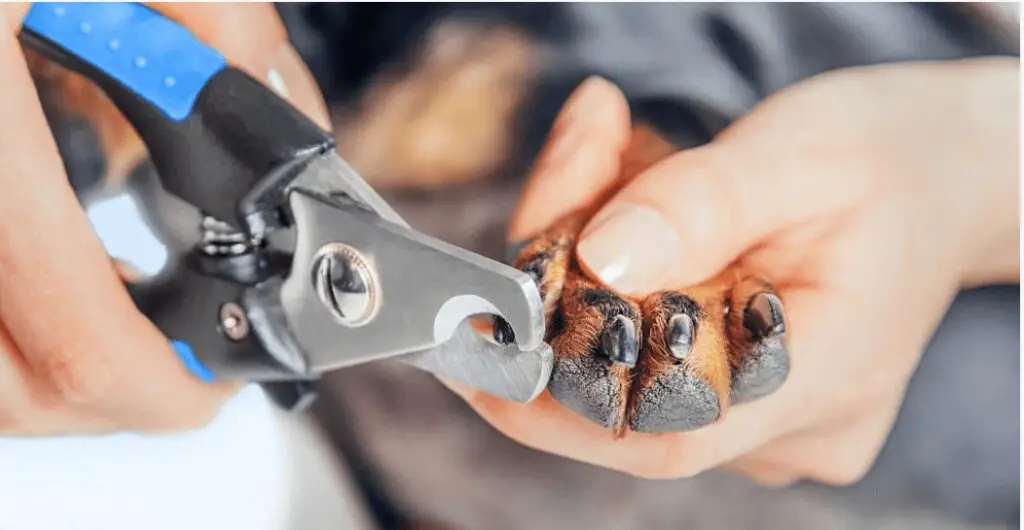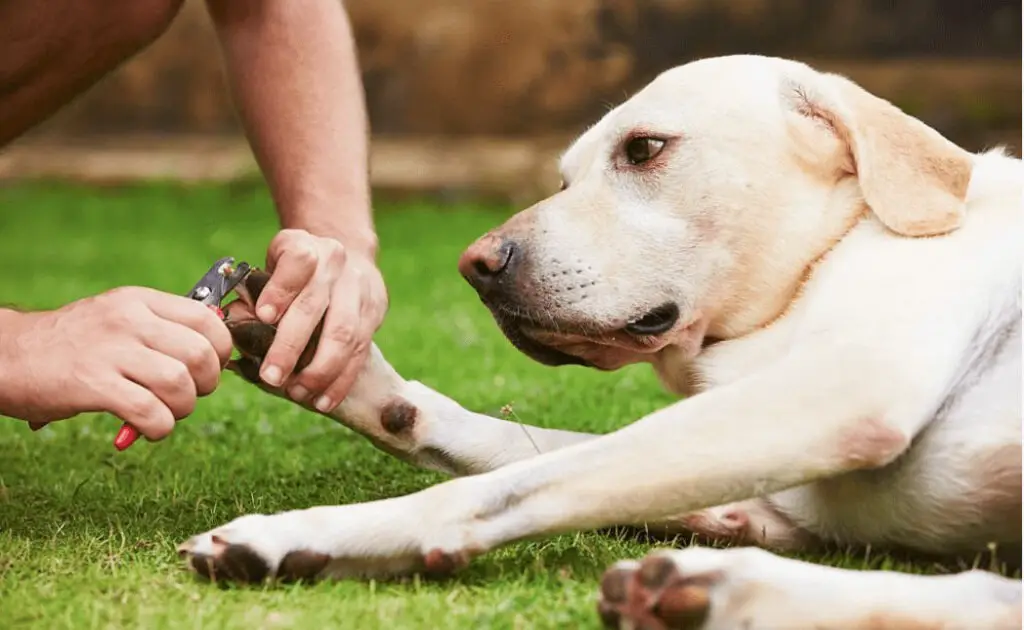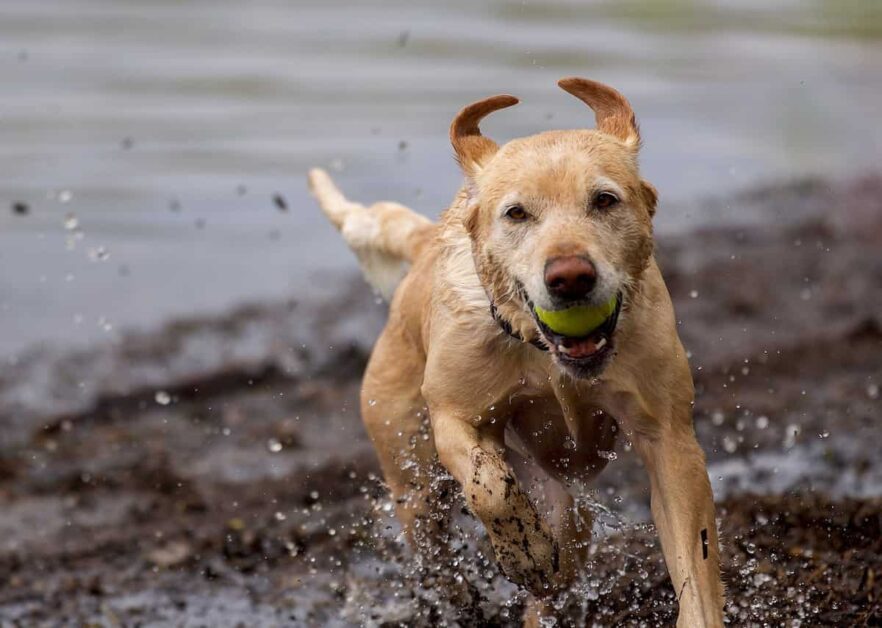Regularly trimming your Labrador’s nails every 2-3 weeks is important to keep them comfortably short. Use proper dog nail clippers and have styptic powder on hand if you cut the quick, which is the blood vessel inside the nail. Hold your dog’s paw gently but firmly and only trim a small amount at a time to avoid hitting the quick.
Give treats and praise to keep them calm and distracted while clipping. Make sure to get all four paws, including the rear dewclaws. Go slowly and reward them for cooperating. Proper nail care will keep your Lab comfortable and prevent problems.
Does It Hurt Dogs To Have Long Nails?
Long human nails cause discomfort. But is it the same for dogs? Does it hurt dogs to have long dark nails?
The answer is yes.
Long black nails can curl under, causing them to dig into the pad of the dog’s paw. It is uncomfortable and can lead to health conditions like infection and inflammation. Overgrown nails cause your dog’s toes to spread, resulting in a strain on their tendons and ligaments, leading to pain and discomfort.
Long nails can also affect your dog’s gait and posture, leading to arthritis. It makes it difficult for your dog to walk on slick surfaces, like hardwood floors, leading to slips and falls.

What Is The Quick In A Labrador Dog’s Nail?
Your dog’s nail contains blood vessels and nerve endings called the quick. Identifying the quick before trimming your labrador retriever’s nails is essential. Cutting into the quick can cause your dog pain, which may bleed excessively. Be careful of the forefinger.
What To Do When You Cut Into The Quick?
Accidents can happen, and even the most experienced dog owners can cut into the quick or tip of the nail. If you do, don’t panic.
- Apply a double coat of styptic powder or cornstarch to the dog’s nail on the small cuts. It’ll help to clot the blood supply and stop the blood flow.
- A soap residue or flour bar can also work. Apply firm pressure to the affected nail and hold it for a few minutes until the bleeding stops.
- After the bleeding stops, keep your dog calm. Take precautions to avoid reopening the the wound.
- Ensure to monitor the nail for any signs of infection. Keep an eye on it.
How To Trim Labrador Nails: Factors
While it may seem daunting, trimming your dog’s nails for its well-being is essential. Let’s consider why it’s important and some tips to make the whole process easier.
Different Growth Rates
One thing to remember when trimming your labrador retriever’s nails is that they may grow at different rates. Some dogs may need their nails trimmed every two to four weeks, while others may be able to go for six to eight weeks between trimmings.
The nail growth rate of your labrador retriever’s nails will depend on various factors, including the breed of dog, age, activity level, and diet.
Puppies, for example, may need more frequent nail trims because their nails grow faster during their early growth stages. On the other hand, an older dog may require less regular nail trimmings because their nails grow more slowly as they age.
Wear And Tear
Another factor to consider during nail trimming is the wear and tear on their nails. If your dog frequently walks or runs on hard surfaces such as concrete or pavement, their nails will become worn down. You have to trim your dog’s nails less frequently.
Conversely, if your dog spends most of their time indoors or on soft surfaces like grass, their nails may not wear down and require more frequent trimming.

Can You Cut Your Dog Nails Yourself?
You may think you can trim your dog’s nails if you are a dog owner. Yes, you can do it yourself. However, it is crucial to understand the types of nail clippers in the market. Learn how to cut labradors nails using them.
Types Of Nail Clippers
Scissor Style:
This kind of dog nail clipper operates similarly to scissors, using the force of your hand. It’s recommended for large dogs with thicker dew claws. It quickly removes excess nails that may cause discomfort. However, using this type requires more precision. It can be challenging to use on dogs that move around or are anxious.
Additionally, smaller dogs with fragile claws may not be suitable for this type of nail trimmer. The more significant scissor-like cuts can cause nails to splinter if they are brittle. Miller’s Forge Nail Trimmers is a good option for a large but calm dog.

Guillotine Style:
This dog clipper operates by placing your pet’s nail in a hole and pressing a “guillotine style” blade to cut off the claw’s end. Be cautious about how far you insert the nail inside the hole since taking off too much can cause harm.
Many pet owners prefer this option as it is easier than the scissor type. It is suitable for small to medium-sized dogs. Moreover, it is less likely to break or splinter your pet’s claws, especially if they have brittle paw points.

But, this option may only sometimes provide a smooth finish. The guillotine clippers’ cut can leave a blunt and curved shape that can scrape you or your pet if they jump up to scratch. On the positive side, it is more manageable than the previous option.
How Do You Teach Your Dog To Accept Nail Clipping?
Are you tired of struggling with your furry friend during nail-clipping sessions? Do you find yourself dreading the process?
Don’t worry; you’re not alone! Teaching dogs to accept nail clipping can be a challenge. With patience and persistence, you can achieve this task. Here are some tips for teaching your dog to accept nail clipping.
Start Early
The earlier you introduce your puppy to nail clipping, the better. Gradually introduce your pup to nail clipping by touching and holding their paws. It helps them get used to the sensation of having their paws handled.
Use Distractions
Using distractions can be a helpful technique for keeping your dog calm during nail-clipping sessions. Give them a tasty treat or a toy to focus on while you clip their nails. It can help keep them distracted and less anxious during the whole process.
Take Breaks
Take a break if your dog becomes too anxious or overwhelmed. It allows them time to calm down and reduces the chance of injury. Try again later when they are more relaxed.
Consider Professional Help
If you still need help teaching your dog to accept nail clipping, consider seeking professional help. A professional veterinarian or groomer can provide tips and techniques to help make the process easier.
How To Clip An Anxiour Dog’s Nails Properly?
Here are some thumb rules on how to clip a nervous dog’s nails:
1. Acclimatise Your Dog To Seeing Nail Clippers
To get your dog accustomed to seeing nail clippers:
- Keep them on the table. Place the clippers within your dog’s line of sight and allow them to approach and sniff the clippers at their own pace.
- When your dog shows curiosity towards the clippers, praise them.
- Keep repeating this process multiple times until your dog becomes comfortable with the clippers being around.
2. Teach Your Dog To Allow Paw Handling
Before using the nail clippers, your dog needs to be comfortable with having their paws handled. Start by touching and massaging the paws of the hind legs while giving them lots of praise and high-value treats. It will help them associate paw handling with positive experiences.
3. Familiarize Your Dog With The Sound The Clippers Make
The sound of the nail clippers can be terrifying for some dogs. Getting them used to the sound before using them is essential.
- Start clipping a piece of paper with the clippers to create a similar sound.
- Again, praise and their favorite treats will help your dog associate the sound with a positive experience.
4. Mix Dog’s Paw Handling With The Clippers
Once your dog is comfortable with paw handling and the sound of the clippers, it’s time to start using them. But wait to start by actually clipping the nails.
Instead, mix in the sound of the clippers while handling their paws. It will help your dog get used to the sensation of the clippers without the added pressure of cutting the nail.
5. Give Them Lots Of Treats
Positive reinforcement is critical in helping a nervous dog get used to nail clipping. Give your dog lots of tasty treats and praise. It will help them associate the entire experience with positive outcomes.
6. Try To Trim Your Dog’s Nail
Once your dog is comfortable with all of the above steps, it’s time to try to trim its nails.
- Begin by trimming the end of the nail, ensuring that you maintain a steady hand.
- If your dog is uncomfortable, take a break and return to it later.
- With time and patience, your dog will become more comfortable.

FAQ: How To Trim Labrador Nails
How Short Should You Cut Your Dog’s Nails?
Cut your dog’s nails just below the quick, pink part of the nail. Avoid cutting too close to the quick to prevent pain and bleeding.
How To Stop A Dog’s Toenail From Bleeding?
To stop the bleeding of your dog’s nail, apply pressure to the affected area using a clean cloth or gauze for a few minutes. You can also use cornstarch or styptic powder for this purpose. In case the bleeding continues, get in touch with vet care.
How To File Your Dog’s Nails To Smooth Them After Clipping
To eliminate rough edges or sharp edges left after clipping, utilize a nail file or grinder. File in one direction and avoid filing too much or too often, as it can damage the nail.
What Length Should A Labrador’s Nails Be?
Labrador retrievers’ nails should be kept at a length just above the floor when they stand.
How Do You Cut A Black Lab Dog’s Nail?
Cutting a black Lab’s nails is the same as cutting any other dog’s nails. Use a sharp and sturdy nail clipper, and cut the nail just below the quick.
What Is The Trick To Cutting A Dog’s Nail?
The trick to cutting a dog’s nails is to start with short but regular trimming sessions. Use high-quality nail clippers. Reward your dog after each successful trimming session.
What To Do When Dog Won’t Let You Cut Dog Nails?
If your dog won’t let you cut its nails, take a break and try again later.
What Angle Do You Cut A Dog’s Nails?
Cut a dog’s nails at a 45-degree angle, sloping downward from the nail’s base towards the tip.
How Do Groomers Cut Difficult Dog’s Nail?
Groomers use various techniques to cut difficult dogs’ nails, such as using a muzzle or a calming spray. They may even use a grooming table or a towel to restrain the dog and have an assistant to hold it.
Is It Better To Grind Or Clip Dog Nails?
Grinding and clipping dog nails are both acceptable ways to aid in dog nail trimming. A nail grinder is less likely to cause bleeding and is helpful for dogs with thick and tough nails. Clipping is faster and more straightforward for dogs with thinner nails.
Does Walking Your Dog Trim Their Nails?
Walking your dog on hard surfaces can help wear down their nails naturally, but it may not be enough to keep their nails trimmed.
Why Do Dogs Cry When Cutting Nails?
Dogs may cry when cutting nails because they are anxious, uncomfortable, or in pain. They may also be scared of the clippers or the process itself.
Author Profile

- Lifetime dog Enthusiast
- Shradha is a seasoned writer at Labradorandyou.com, an authoritative resource for all things Labrador Retriever. Her experience as a pet owner and dog enthusiast drives her to create meticulously researched and fact-checked content, offering valuable insights on Labrador training, grooming, and health. Each article reflects Shradha's passion and dedication, enriched by personal experiences with her beloved Labradors, Tom, and Kurt. Whether exploring breed-specific training techniques or providing product reviews, Shradha ensures Labrador owners receive the most accurate, up-to-date, and trustworthy information, aimed at enhancing their companions' health and happiness
Also by the author
-
 FAQNovember 17, 2023Old Dog Seizures: Causes, Symptoms, and Treatment Options
FAQNovember 17, 2023Old Dog Seizures: Causes, Symptoms, and Treatment Options
-
 FAQNovember 16, 2023Complete Dog Medicine Dosage Chart Declassified
FAQNovember 16, 2023Complete Dog Medicine Dosage Chart Declassified
-
 Lab-InfoNovember 13, 2023What Are The Red Flags When Adopting A Dog?
Lab-InfoNovember 13, 2023What Are The Red Flags When Adopting A Dog?
-
 FAQNovember 13, 2023Are Antlers Safe For Dogs? [ANSWERED]
FAQNovember 13, 2023Are Antlers Safe For Dogs? [ANSWERED]





